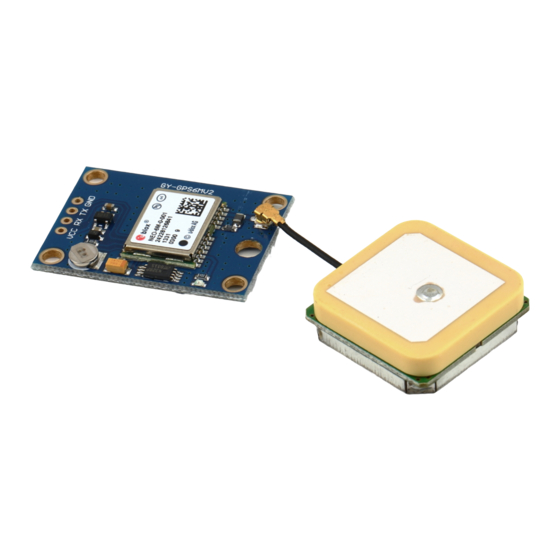Table of Contents
Advertisement
Quick Links
LEA-6 / NEO-6
u-blox 6 GPS Modules
Hardware Integration Manual
Abstract
This document describes the features and specifications of the cost
effective and high-performance LEA-6 and NEO-6 GPS modules
featuring the u-blox 6 positioning engine.
These compact, easy to integrate stand-alone GPS receiver modules
combine exceptional GPS performance with highly flexible power,
design, and connectivity options. Their compact form factors and
SMT pads allow fully automated assembly with standard pick &
place and reflow soldering equipment for cost-efficient, high-
volume production enabling short time-to-market.
www.u-blox.com
Downloaded from
DatasheetLib.com
- datasheet search engine
Advertisement
Table of Contents

Summarization of Contents
Preface
u-blox Technical Documentation
Overview of technical documentation available from u-blox for product support.
How to use this Manual
Guidance on navigating the modular structure of the Hardware Integration Manual.
Technical Support
Worldwide Web Access
Accessing product information, technical documents, and FAQs on the u-blox website.
Contacting Support via E-mail
Procedure for contacting u-blox technical support offices via email for assistance.
Information for Technical Support
Required information to provide when contacting technical support for efficient problem resolution.
Hardware Description
Overview of u-blox 6 Modules
Introduction to LEA-6 and NEO-6 standalone GPS receiver modules and their features.
Module Architecture
Description of the RF and Baseband sections comprising the LEA-6 and NEO-6 modules.
Power Management
Details on power supply pins (VCC, V_BCKP, VDDUSB) and their functions for module operation.
Antenna Supply and Supervision
Information on supplying active antennas via V_ANT and antenna supervision features.
System Functions
Explanation of system functions like EXTINT pin and system monitoring capabilities.
Module Interfaces
Description of serial interfaces including UART, USB, DDC, and SPI for module communication.
I/O Pins Description
Detailed description of various I/O pins on LEA-6 and NEO-6 modules and their functions.
Design-in
Design-in Checklist
Key considerations for successful GPS module integration, including power supply and layout.
Design Considerations
Essential functions and pins to consider for a minimal design with u-blox 6 GPS modules.
LEA-6 Design Examples
Minimal setup examples for LEA-6 receivers, including passive antenna designs.
NEO-6 Design Examples
Minimal setup examples for NEO-6 receivers, including passive antenna designs.
PCB Layout Recommendations
Information on footprint, paste mask, placement, and grounding for optimal GPS system layout.
Antenna Connection and Grounding
Guidelines for connecting antennas and designing grounding planes for reliable GPS performance.
Antenna Micro Strip Design
Calculation and design principles for micro strip lines used in antenna connections.
Antenna and Supervisor
Considerations for passive and active antennas, including LNA and antenna supervisor circuits.
Product Handling
Packaging, Shipping, and Storage
Information on packaging, shipping, storage, and moisture preconditioning for GPS modules.
Soldering Guidelines
Recommendations for soldering paste, reflow soldering, optical inspection, and cleaning processes.
EOS/ESD/EMI Precautions
Measures to prevent damage from Electrostatic Discharge, Electrical Overstress, and Electromagnetic Interference.
Product Testing
In-Series Production Test
Description of u-blox' automatic test equipment and measurements for module quality assurance.
OEM Manufacturer Test Parameters
Key parameters for OEM manufacturers to focus on during their production testing.
System Sensitivity Test
Methods and guidelines for testing GPS device sensitivity using a GPS simulator.
Appendix
Abbreviations
List and definitions of abbreviations used throughout the document.
Migration to u-blox 6 Receivers
Guidance on migrating existing ANTARIS4 and u-blox5 designs to u-blox 6 modules.
Interface Backgrounder
DDC Interface
Explanation of the two-wire serial data and clock interface (SDA/SCL) for device communication.
SPI Interface
Description of the Serial Peripheral Interface (SPI) communication protocol and its basic principles.







Need help?
Do you have a question about the LEA-6T and is the answer not in the manual?
Questions and answers